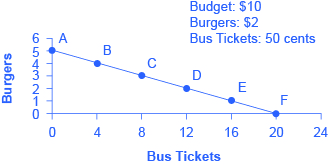| << Chapter < Page | Chapter >> Page > |
By the end of this section, you will be able to:
Consider the typical consumer’s budget problem. Consumers have a limited amount of income to spend on the things they need and want. Suppose Alphonso has $10 in spending money each week that he can allocate between bus tickets for getting to work and the burgers that he eats for lunch. Burgers cost $2 each, and bus tickets are 50 cents each. [link] shows Alphonso’s budget constraint , that is, the outer boundary of his opportunity set . The opportunity set identifies all the opportunities for spending within his budget. The budget constraint indicates all the combinations of burgers and bus tickets Alphonso can afford when he exhausts his budget, given the prices of the two goods. (There are actually many different kinds of budget constraints. You will learn more about them in the chapter on Consumer Choices .)

The vertical axis in the figure shows burger purchases and the horizontal axis shows bus ticket purchases. If Alphonso spends all his money on burgers, he can afford five per week. ($10 per week/$2 per burger = 5 burgers per week.) But if he does this, he will not be able to afford any bus tickets. This choice (zero bus tickets and five burgers) is shown by point A in the figure. Alternatively, if Alphonso spends all his money on bus tickets, he can afford 20 per week. ($10 per week/$0.50 per bus ticket = 20 bus tickets per week.) Then, however, he will not be able to afford any burgers. This alternative choice (20 bus tickets and zero burgers) is shown by point F.
If Alphonso is like most people, he will choose some combination that includes both bus tickets and burgers. That is, he will choose some combination on the budget constraint that connects points A and F. Every point on (or inside) the constraint shows a combination of burgers and bus tickets that Alphonso can afford. Any point outside the constraint is not affordable, because it would cost more money than Alphonso has in his budget.
The budget constraint clearly shows the tradeoff Alphonso faces in choosing between burgers and bus tickets. Suppose he is currently at point D, where he can afford 12 bus tickets and two burgers. What would it cost Alphonso for one more burger? It would be natural to answer $2, but that’s not the way economists think. Instead they ask, how many bus tickets would Alphonso have to give up to get one more burger, while staying within his budget? The answer is four bus tickets. That is the true cost to Alphonso of one more burger.

Notification Switch
Would you like to follow the 'Principles of economics' conversation and receive update notifications?